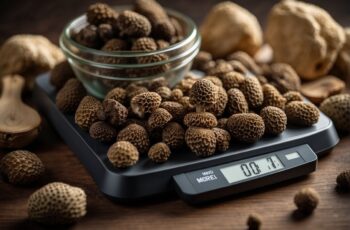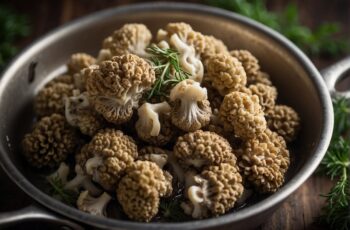Frozen morels offer a way for you to enjoy these highly prized mushrooms year-round. Known for their unique honeycomb appearance and deep, earthy flavor, morel mushrooms are a springtime favorite among foragers and chefs alike. Outside their brief wild harvest season, frozen morels stand in as a versatile and convenient alternative. Preserving morels by freezing maintains much of their texture and flavor, making them a valuable ingredient in gourmet dishes.
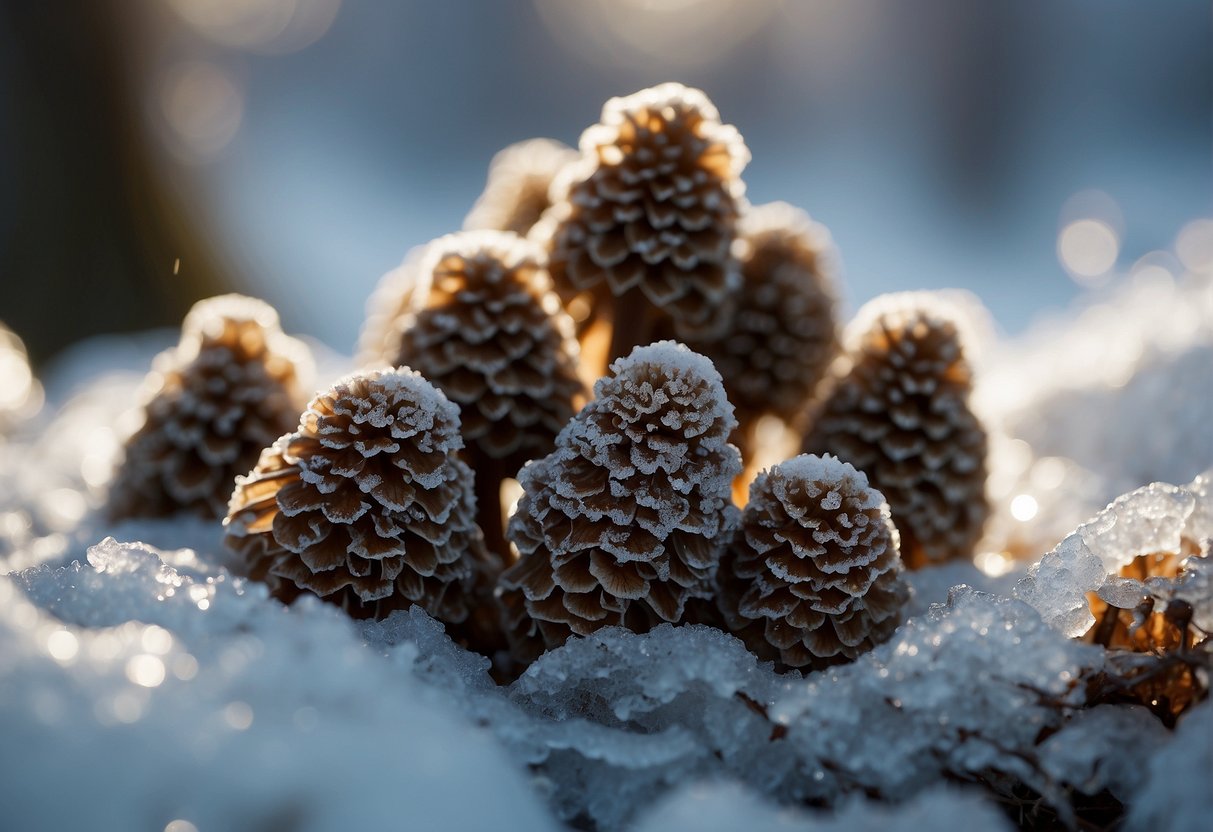
When considering frozen morels, your first thoughts may be of their potential in your culinary adventures. The process of freezing locks in the freshness and means that with a little preparation, you can have the essence of spring at your fingertips any time of the year. It’s essential to know how to thaw and prepare these fungi to retain their unique characteristics best. Careful handling and proper cooking techniques can transform these frozen gems into a delicious complement to your meals.
Key Takeaways
- Frozen morels provide a convenient option for enjoying this sought-after mushroom outside its natural growing season.
- Proper thawing and preparation are crucial to preserving the integrity of morels’ texture and flavor when cooking.
- Morels can elevate dishes with their distinct, woodsy taste, making them a favorite in gourmet cooking.
Harvesting and Cleaning
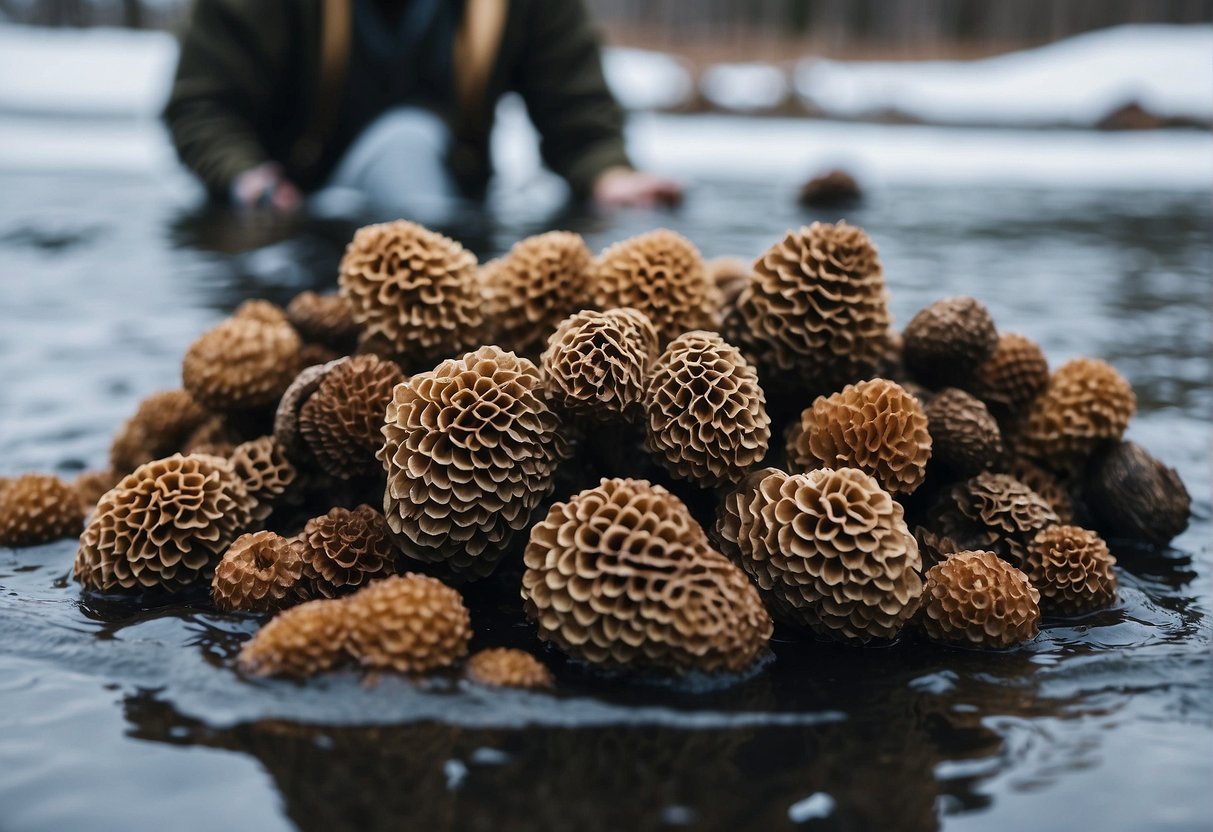
Before you venture into the wilderness to find fresh morel mushrooms, it’s essential to know how to properly harvest and clean your bounty. By following the right techniques, you ensure that your morels are free of dirt, debris, and any potential contaminants, making them ready for your culinary uses.
Identifying Morels
It’s crucial to accurately identify morels (Morchella) due to their similarity to non-edible, toxic mushrooms. Fresh morel mushrooms have a distinctive honeycomb appearance on their cap, which is attached directly to the stalk. When you spot a potential morel, check for the presence of a hollow inside from stem to tip—this is a hallmark of a true morel. Typically, morel hunting is most successful near trees like ashes, elms, and poplars, which provide the natural nooks and crannies these fungi favor.
Gathering and Transporting
Once you’ve identified morel mushrooms, it’s time to harvest them. Carefully pinch or cut the stem at the base, avoiding pulling which can disturb the mycelium below. When transporting your fresh morels, use a mesh bag or a basket. This allows spores to disperse back into the forest, potentially giving life to new mushrooms in the seasons to come. Keep the morels cool and dry during transport to preserve their freshness.
Cleaning Techniques
Cleaning your fresh morels is a delicate process to remove any dirt or small insects hiding in the crevices. Start by giving the morels a quick rinse under running water. Some morel enthusiasts also recommend soaking them in saltwater to dislodge any stubborn debris. After rinsing or soaking, take time to inspect each morel closely, gently brushing off any remaining dirt. Pat them dry with paper towels carefully to eliminate excess water before storing or cooking them. This attention to detail ensures a clean, enjoyable, and safe eating experience.
Preservation Methods
Ensuring that your morel mushrooms maintain their quality throughout storage is crucial. Proper preservation methods can drastically extend their shelf life without sacrificing flavor or texture.
Drying and Storing
Drying is a straightforward approach to preserve morels and it’s one that you can easily do at home. Air drying involves slicing the morels in half lengthwise and arranging them on a drying rack, where they can dehydrate naturally. For a quicker method, you could opt for oven drying; setting your oven to the lowest temperature and leaving the door slightly open to allow for airflow. Whichever approach you choose, the goal is to achieve ‘cracker dry‘ morels, meaning they snap easily when bent.
-
Air Drying Techniques:
- Clean and halve morels lengthwise.
- Arrange on a drying rack in a well-ventilated area.
- Allow several days for complete drying, checking regularly.
-
Oven Drying:
- Preheat oven to 95-115°F (35-46°C), door ajar.
- Place morels on a baking sheet lined with parchment paper.
- Dry for several hours, checking periodically until cracker dry.
Stored properly in an airtight container, dried morels can last for up to two years without losing their distinctive flavor.
Freezing for Longevity
Freezing is another reliable preservation method that can keep your morels in top form for months. Begin by cleaning the morels thoroughly and consider pre-breading if you plan to cook them later. Quickly blanching them before freezing can help preserve texture, taste, and nutritional value. Then, freeze morel mushrooms on a baking sheet before transferring them to a freezer-safe airtight container. This prevents them from sticking together, making it easier to remove individual portions as needed.
- To Freeze Morels:
- Clean and optionally bread the fresh morels.
- Blanch if desired, then cool quickly using ice water.
- Dry off with a paper towel to remove excess moisture.
- Spread on a tray to freeze individually before storing in a freezer-safe container.
Remember, when you’re ready to enjoy your frozen morels, thaw them partially under warm water if they’re unbreaded, or allow them to reach room temperature if they’re pre-breaded. Properly frozen morels can last for up to six months, and cooking instructions suggest not moving them around in the pan until one side is browned well, ensuring a flavorful result.
Culinary Applications
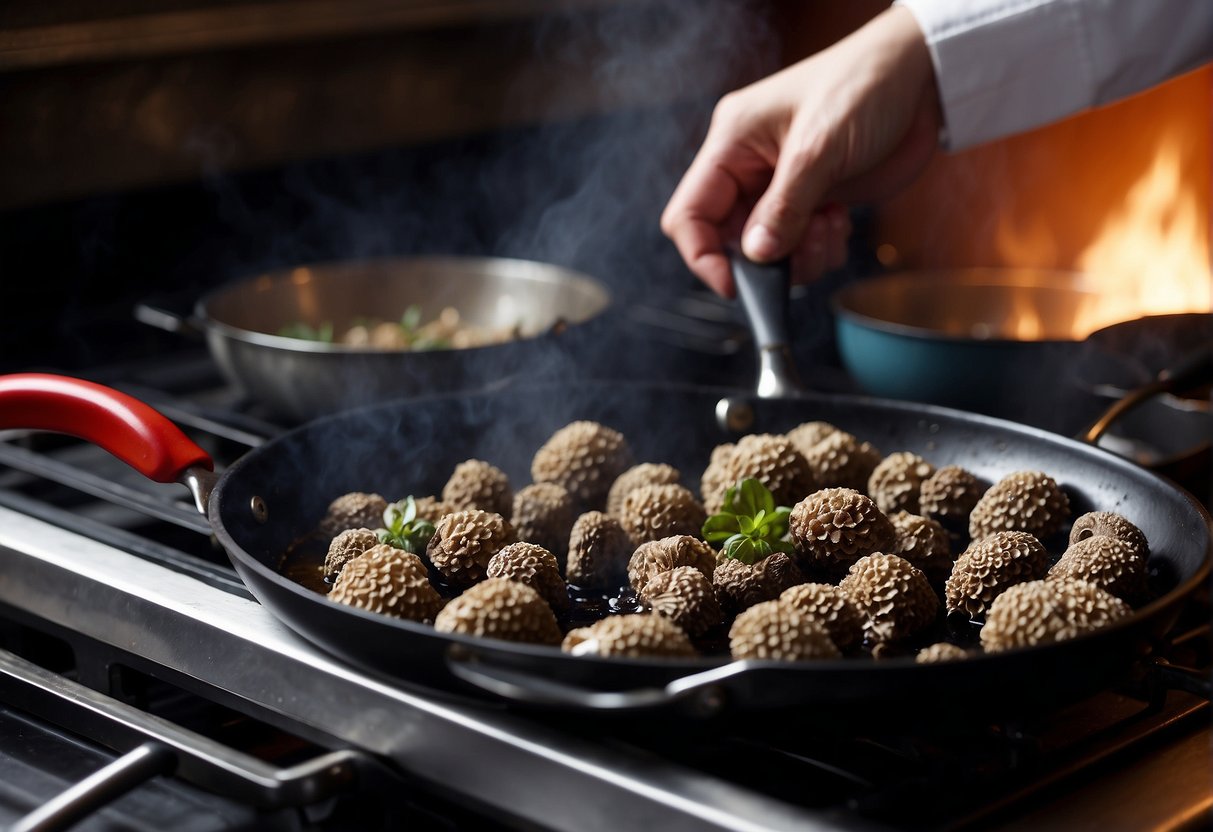
Frozen morels are a game-changer in the kitchen, offering both a distinctive earthy flavor and a meaty texture that can elevate your dishes. Thaw them properly and you’re ready to outdo yourself in a variety of recipes.
Cooking with Frozen Morels
To unlock the full potential of frozen morels, they require careful sautéing. Start by thawing them to preserve their texture. Then, heat a pan with a mixture of butter and olive oil; this combination allows for even cooking and enhances the mushrooms’ natural taste. Cook them until they achieve a golden brown hue which signals a perfect sauté. Adding finely chopped shallots can infuse the morels with a subtle piquancy, intensifying their earthy flavor.
- Seasoning: Be judicious with your seasonings; a pinch of pepper and a discreet amount of garlic can complement morels’ unique taste without overshadowing it.
- Thickening Agents: When looking to thicken sauces or soups, flour may be used sparingly alongside the morels to create a base that lends creamy texture.
Morel Pairings and Substitutes
Morels are versatile in their pairing abilities. For a hearty entrée, incorporate morels into risottos or pasta dishes, where their robust flavor shines. They marry well with roast meats, with their savory quality holding its own against rich flavors.
- Complementary Liquids: A splash of wine in the pan while cooking morels can bring out their complex notes.
- Cream: Adding a dash of cream introduces a luxurious dimension to stews and sauce-based dishes, perfect for those times you yearn for indulgence.
When morels aren’t available, seek substitutes that mimic their texture and flavor. Porcini mushrooms can be a reliable stand-in, especially in earthy, umami-rich recipes. However, note that each mushroom species brings its unique charm to the table, so expect a slight alteration in the final taste profile.
Thawing and Preparing for Cooking
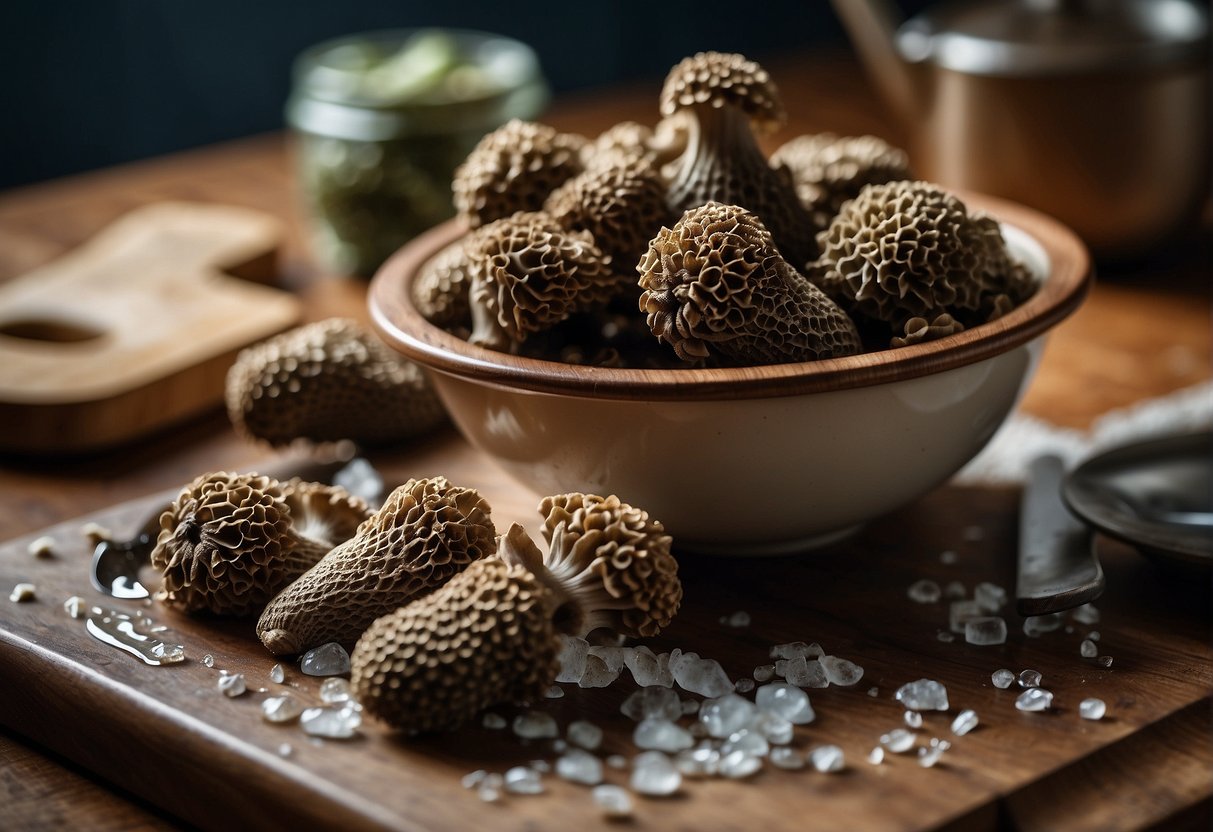
When you’re working with frozen morels, it’s critical to properly thaw and prepare them for cooking to maintain their delicate texture and woodsy flavor.
Defrosting Techniques
Refrigerator Thawing: For the most even and gentle thawing, place your frozen morels in the refrigerator. This slow process may take several hours but will prevent the mushrooms from becoming waterlogged, preserving their structure. For best results, position the morels on a plate lined with a paper towel to absorb any excess moisture.
Room Temperature Thawing: If you’re pressed for time, lay your frozen morel mushrooms on a paper towel at room temperature. This method is quicker, taking about an hour. Keep an eye on them to ensure they do not become too soft or lose their texture.
Pre-Cooking Preparation
Drying: Once the morels are thawed, they should be patted dry gently with paper towels. Ensuring that the mushrooms are not damp will help achieve a better sear and prevent a mushy texture during the cooking process.
Slicing: If the morels are large, they can be cut in half from top to bottom. Smaller morels can be cooked whole. This step promotes even cooking and allows heat to penetrate the mushrooms more effectively.
By properly defrosting and prepping your frozen morels, you’ll set the stage for a delicious woodland feast with ideal flavor and texture.

